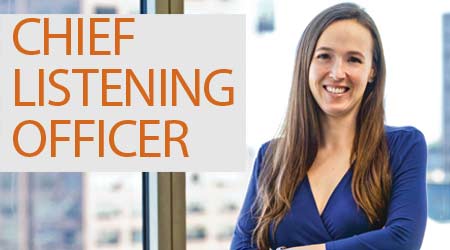 In four years, Sara Neff, senior vice president of sustainability at Kilroy Realty, led the REIT from no formalized sustainability program to being the top-ranked real estate company across all asset classes.
In four years, Sara Neff, senior vice president of sustainability at Kilroy Realty, led the REIT from no formalized sustainability program to being the top-ranked real estate company across all asset classes.For Facility Managers, Networking is Essential for Sharing Best Practices
Neff makes sure to connect with tenants and maintain a keen awareness of current trends. This includes health and wellness certifications, like Fitwel and WELL.
Facility managers are often told how important networking is for sharing best practices, but to push into a leader position Neff says you have to take it one more level and look outside of real estate. It’s important to go to industry conferences and stay up to date on research, but “you have to think about what the most forward thinking companies on sustainability are doing,” she says.
Kilroy benefits from having attracted some large innovative companies, like Salesforce, to their portfolio, and they spend time connecting with these tenants on what their key initiatives are, says Swartz. “Look for those leaders in the community that are not doing real estate, but in many ways impact real estate,” says Swartz. While the West Coast might have a greater concentration of companies widely recognized for being eco-savvy, any market in the country will have leaders facility managers can look to, says Swartz. “Any market has brand leaders,” he says. “Those are the people to try to stay in front of. Try to make sure that you’re addressing their needs so that your building can be an attractive alternative for them.”
Doing real estate disclosures and also disclosures that are more universal, like the Dow Jones Sustainability Index or the Carbon Disclosure Project have been instrumental as well for broadening Neff’s perspective on what’s possible in sustainability, she says. “That shows you, given the questions that they ask, what other companies are thinking about, and then that shows you what you should be thinking about,” Neff says. Biodiversity is one example. “I don’t think I would have had a biodiversity program if a couple of the more universal disclosures hadn’t asked me about one,” she says.
That strategy of staying aware of general trends allows Kilroy to avoid being found flat-footed when a critical category or tool coalesces into viability in the market. “It’s a matter of staying abreast of what’s happening and also being nimble enough to have a response of some kind to it,” she says. Health is one example of Kilroy’s nimbleness. For a couple of years, the industry had been talking about health as an important area of focus, but the tools to take action on it didn’t yet exist, Neff says. When Fitwel and WELL came out, Neff saw that the programs meshed well with what Kilroy wanted to do, with “features that add clear scientifically based value.” So, Kilroy jumped in. “And when we jump in, we jump in big,” Neff says. “Within the first year, we had the most Fitwel-certified property of any non-government real estate holder.” The portfolio is currently 23 percent Fitwel certified. In addition, Kilroy has the first WELL-certified residential rental units in the world.
Now years into a leadership position on sustainability, it might be easy to assume Kilroy has picked all the juicy fruit already, but Neff doesn’t see it that way. “I believe in human innovation,” she says. “I believe in ingenuity, so new low-hanging-fruit technologies will keep coming onto the market.” That, coupled with a wealth of attractive incentive programs at the moment, will keep Neff busy. “This year, I’m not low on projects."
Naomi Millán can be reached at naomi.millan@tradepress.com.
Related Topics:















